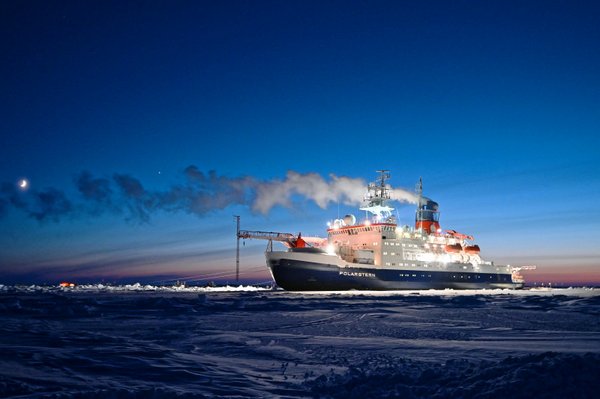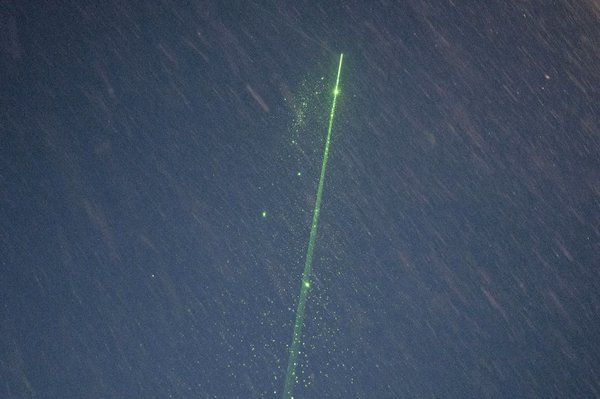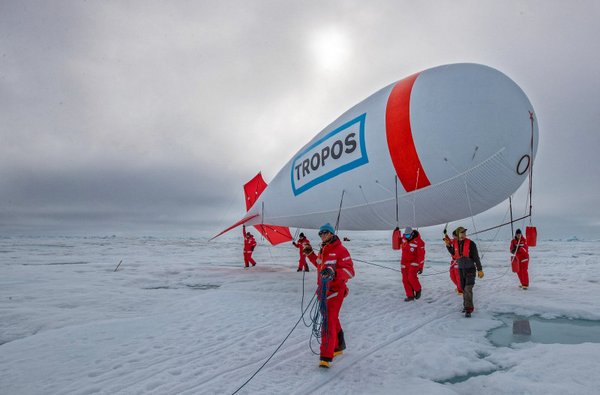Deep insights into the Arctic of tomorrow
Leipzig,
07.02.2022
First interdisciplinary results of MOSAiC drift published – with contributions from Leipzig on the atmosphere
Bremerhaven/Leipzig. Hundreds of international researchers are currently analysing observations from the one-year MOSAiC expedition, during which hundreds of environmental parameters were recorded with unprecedented accuracy and frequency over a full annual cycle in the Central Arctic Ocean. They have now published three overview articles on the MOSAiC atmosphere, snow and sea ice, and ocean programs in the journal Elementa, highlighting the importance of examining all components of the climate system together. These results present a first interdisciplinary picture of the climate processes in the central Arctic which is warming more than two times as fast as the rest of the planet - processes which affect weather and climate worldwide.
With these results from the three MOSAiC teams Atmosphere (ATMOS), Physical oceanography (OCEAN) as well as Snow and sea ice (ICE) coming out now, the researchers are building the most complete observation-based picture of climate processes in the Arctic, where the surface air temperature has been rising more than two times as fast as on the rest of the planet since the 1970s. To study the relevant processes for a full year required a special concept, in part because the Central Arctic Ocean is still ice-covered in winter and therefore difficult to access. During the expedition from September 2019 to October 2020, the icebreaker froze to a large ice floe and drifted with the natural transpolar drift across the Arctic Ocean – faster than expected.
One of the reasons for the rapid drift is provided by the analysis of the atmospheric research team: "Near the surface there were particularly low temperatures and associated persistent strong winds in the winter months that pushed Polarstern faster than expected. Large-scale atmospheric pressure and wind patterns in January to March led to a particularly strong polar vortex around the Arctic, in addition to a record ozone hole in the Arctic stratosphere," explains Dr Matthew Shupe, atmospheric scientist at CIRES at the University of Colorado and NOAA and co-leader of Team Atmosphere.
Within the framework of the atmospheric programme, the international team has achieved numerous observational successes that are a novelty in the central Arctic. For example: continuous observations with lidar and radar; annual cycles of ice nucleus particle concentrations, surface fluxes of climate-active trace gases, aerosol chemistry and microphysics or temporally highly resolved air humidity profiles over the sea ice. Researchers from Leipzig at the Leibniz Institute for Tropospheric Research (TROPOS) and the Leipzig University have played a decisive role in these successes:
During MOSAiC, a coherent, vertically resolved view of aerosols, clouds and water vapour in the central Arctic up to an altitude of 30 km was created for the first time. For this, a multi-wavelength lidar of TROPOS measured the air layers from on board the research icebreaker. In 369 days, 640 million laser pulses went into the sky and 112 gigabytes of data were collected. "We were able to observe smoke from forest fires in Siberia for the first time, which was still hovering over the central Arctic even during the polar night. This observation has led to a new hypothesis: There is much to suggest that forest fires contribute to the formation of polar stratospheric clouds (PSCs) and thus to the ozone hole. The large forest fires in North America, Siberia or Australia could therefore be partly responsible for the fact that large ozone holes have formed again over the poles in recent years. If the connection is confirmed, then climate change would take on another dimension," explains Prof. Andreas Macke, Director of TROPOS.
TROPOS and the Leipzig University jointly operated the tethered balloon BELUGA on the ice floe during the summer. The balloon filled the gap between measurements on the ground and the upper layers, providing important data on the particularly critical bottom layer, which contributes significantly to the warming of the Arctic.
"Accompanying aircraft measurements were carried out from Spitsbergen together with the AWI and other project partners. For some measurement cases, it was thus possible to show that there have so far been considerable problems in modelling the change in clouds on their way from the inner Arctic (starting from Polarstern) southwards (to Spitsbergen, where the aircraft measurements took place)," explains Prof. Manfred Wendisch, head of the Institute of Meteorology at the Leipzig University. The collected data will now help to better understand the complex system of the Arctic and significantly improve the climate models.
The three overview articles serve as references for a vast array of future scientific work. "The physical observations are the basis for interpreting biogeochemical cycles and ecosystem processes, and for supporting coupled models that we use to learn even more about climate feedbacks and the global repercussions of Arctic change. These changes can affect weather and climate worldwide," says Prof. Markus Rex, head of MOSAiC and atmospheric scientist at the AWI. "It is fascinating how accurately we can map individual processes and relate them to each other. I am pleased to see how several hundred MOSAiC participants have collaborated on these publications. International cooperation with expedition participants from so many countries continues productively in a highly coordinated manner, even though the expedition has been over for more than a year. In this way, we will be able to provide ever more important insights into climate change, which will provide a knowledge base for societal transformation towards a sustainable approach to planet Earth," says MOSAiC leader Markus Rex.
Background information on MOSAiC
During the Multidisciplinary drifting Observatory for the Study of Arctic Climate (MOSAiC) expedition, experts from 20 nations explored the Arctic for an entire year. From autumn 2019 to autumn 2020, the German research icebreaker Polarstern drifted frozen in the ice through the Arctic Ocean. MOSAiC was coordinated by the Alfred Wegener Institute, Helmholtz Centre for Polar and Marine Research (AWI). In order to make this unique project a success and to obtain the most valuable data possible, more than 80 institutes had pooled their resources in a research consortium. The total cost of the expedition was about 150 million euros, mostly funded by the German Federal Ministry of Education and Research.
Original publications
Shupe, M.D., M. Rex, B. Blomquist, P.O.G. Persson, J. Schmale, T. Uttal, D. Althausen, H. Angot, S. Archer, L. Bariteau, I. Beck, J. Bilberry, S. Bussi, C. Buck, M. Boyer, Z. Brasseur, I.M. Brooks, R. Calmer, J. Cassano, V. Castro, D. Chu, D. Costa, C.J. Cox, J. Creamean, S. Crewell, S. Dahlke, E. Damm, G. de Boer, H. Deckelmann, K. Dethloff, M. Dütsch, K. Ebell, A. Ehrlich, J. Ellis, R. Engelmann, A.A. Fong, M.M. Frey, M.R. Gallagher, L. Ganzeveld, R. Gradinger, J. Graeser, V. Greenamyer, H. Griesche, S. Griffiths, J. Hamilton, G. Heinemann, D. Helmig, A. Herber, C. Heuzé, J. Hofer, T. Houchens, D. Howard, J. Inoue, H.-W. Jacobi, R. Jaiser, T. Jokinen, O. Jourdan, G. Jozef, W. King, A. Kirchgaessner, M. Klingebiel, M. Krassovski, T. Krumpen, A. Lampert, W. Landing, T. Laurila, D. Lawrence, B. Loose, M. Lonardi, C. Lüpkes, M. Maahn, A. Macke, W. Maslowski, C. Marsay, M. Maturilli, M. Mech, S. Morris, M. Moser, M. Nicolaus, P. Ortega, J. Osborn, F. Pätzold, D.K. Perovich, T. Petäjä, C. Pilz, R. Pirazzini, K. Posman, H. Powers, K.A. Pratt, A. Preußer, L. Quéléver, M. Radenz, B. Rabe, A. Rinke, T. Sachs, A. Schulz, H. Siebert, T. Silva, A. Solomon, A. Sommerfeld, G. Spreen, M. Stephens, A. Stohl, G. Svensson, J. Uin, J. Viegas, C. Voigt, P. von der Gathen, B. Wehner, J.M. Welker, M. Wendisch, M. Werner, Z. Xie, F. Yue, 2022: Overview of the MOSAiC expedition – Atmosphere. Elementa, Science of the Anthropocene, 10 (1), DOI: https://doi.org/10.1525/elementa.2021.00060.
Nicolaus, M, Perovich, DK, Spreen, G, Granskog, MA, Albedyll, LV, Angelopoulos, M, Anhaus, P, Arndt, S, Belter, HJ, Bessonov, V, Birnbaum, G, Brauchle, J, Calmer, R, Cardellach, E, Cheng, B, Clemens-Sewall, D, Dadic, R, Damm, E, de Boer, G, Demir, O, Dethloff, K, Divine, DV, Fong, AA, Fons, S, Frey, MM, Fuchs, N, Gabarro, C, Gerland, S, Goessling, HF, Gradinger, R, Haapala, J, Haas, C, Hamilton, J, Hannula, H-R, Hendricks, S, Herber, A, Heuzé, C, Hoppmann, M, H yland, KV, Huntemann, M, Hutchings, JK, Hwang, B, Itkin, P, Jacobi, H-W, Jaggi, M, Jutila, A, Kaleschke, L, Katlein, C, Kolabutin, N, Krampe, D, Kristensen, SS, Krumpen, T, Kurtz, N, Lampert, A, Lange, BA, Lei, R, Light, B, Linhardt, F, Liston, GE, Loose, B, Macfarlane, AR, Mahmud, M, Matero, IO, Maus, S, Morgenstern, A, Naderpour, R, Nandan,V, Niubom, A, Oggier, M, Oppelt, N, Patzold, F, Perron, C, Petrovsky,T, Pirazzini, R, Polashenski, C, Rabe, B, Raphael, IA, Regnery, J, Rex, M, Ricker, R, Riemann-Campe, K, Rinke, A, Rohde, J, Salganik, E, Scharien, RK, Schiller, M, Schneebeli, M, Semmling, M, Shimanchuk, E, Shupe, MD, Smith, MM, Smolyanitsky,V, Sokolov,V, Stanton, T, Stroeve, J,Thielke, L,Timofeeva, A,Tonboe, RT,Tavri, A,Tsamados, M,Wagner, DN,Watkins, D,Webster, M,Wendisch, M. 2022. Overview of the MOSAiC expedition: Snow and sea ice. Elementa: Science of the Anthropocene 10(1). DOI: https://doi.org/10.1525/elementa.2021.000046
Rabe, B, Heuzé, C, Regnery, J, Aksenov, Y, Allerholt, J, Athanase, M, Bai, Y, Basque, C, Bauch, D, Baumann, TM, Chen, D, Cole, ST, Craw, L, Davies, A, Damm, E, Dethloff, K, Divine, DV, Doglioni, F, Ebert, F, Fang, Y-C, Fer, I, Fong, AA, Gradinger, R, Granskog, MA, Graupner, R, Haas, C, He, H, He, Y, Hoppmann, M, Janout, M, Kadko, D, Kanzow, T, Karam, S, Kawaguchi, Y, Koenig, Z, Kong, B, Krishfield, RA, Krumpen, T, Kuhlmey, D, Kuznetsov, I, Lan, M, Laukert, G. Lei, R, Li, T, Torres-Valde ́s, S, Lin, L, Lin, L, Liu, H, Liu, N, Loose, B, Ma, X, MacKay, R, Mallet, M, Mallett, RDC, Maslowski, W, Mertens, C, Mohrholz, V, Muilwijk, M, Nicolaus, M, O’Brien, JK, Perovich, D, Ren, J, Rex, M, Ribeiro, N, Rinke, A, Schaffer, J, Schuffenhauer, I, Schulz, K, Shupe, MD, Shaw, W, Sokolov, V, Sommerfeld, A, Spreen, G, Stanton, T, Stephens, M, Su, J, Sukhikh, N, Sundfjord, A, Thomisch, K, Tippenhauer, S, Toole, JM, Vredenborg, M, Walter, M, Wang, H, Wang, L, Wang, Y, Wendisch, M, Zhao, J, Zhou, M, Zhu, J. 2022. Overview of the MOSAiC expedition: Physical oceanography. Elementa: Science of the Anthropocene 10(1). DOI: https://doi.org/10.1525/elementa.2021.00062
Short citations
ATMOS: Shupe, M.D., M. Rex, B. Blomquist, P.O.G. Persson, J. Schmale, T. Uttal et al., 2022: Overview of the MOSAiC expedition: Physical oceanography. Elementa: Science of the Anthropocene 10(1). DOI: https://doi.org/10.1525/elementa.2021.00062
ICE: Nicolaus, M, Perovich, DK, Spreen, G, Granskog, MA et al., 2022: Overview of the MOSAiC expedition: Snow and sea ice. Elementa: Science of the Anthropocene 10(1). DOI: https://doi.org/10.1525/elementa.2021.000046
OCEAN: Rabe, B, Heuzé, C, Regnery et al., 2022: Overview of the MOSAiC expedition – Atmosphere. Elementa, Science of the Anthropocene, 10 (1), DOI: https://doi.org/110.1525/elementa.2021.00060
MOSAiC Media contacts:
Leipzig contribution to atmospheric research:
Prof. Dr. Andreas Macke
Director Leibniz Institute for Tropospheric Research (TROPOS)
Phone: +49 341 2717-7060
http://www.tropos.de/institut/ueber-uns/mitarbeitende/andreas-macke/
and
Prof. Dr. Manfred Wendisch
Spokesperson for the German Research Foundation's Collaborative Research Centre "Arctic Climate Change (AC)³" and direktor of the Leipzig Institute for Meteorology of the Leipzig University
Phone: +49 341 97-32851
http://www.ac3-tr.de/project-member/prof-dr-manfred-wendisch/
or
Tilo Arnhold, TROPOS public relations
Phone: +49-341-2717-7189
https://www.tropos.de/en/current-issues/press-releases
as well
Susann Huster
Press officer
Media team of Leipzig University
Phone: +49 341 97-35022
https://www.uni-leipzig.de/en/university/structure/administration-and-offices/office-for-university-communications/#c297120
Germany & international:
- Atmosphere and project lead:
- Ice:
- Ocean:
- Press office at the Alfred Wegener Institute: Folke Mehrtens (phone: +49 471 4831-2007; email: media@awi.de)
Further information:
Climate change and wildfires could increase ozone hole (Press release, 21 Jan 2022):
https://www.tropos.de/en/current-issues/press-releases/details/klimawandel-und-waldbraende-koennten-ozonloch-vergroessernUnique view into the "new Arctic": International MOSAiC expedition successfully completed (Press release, 12 Oct 2020):https://www.tropos.de/en/current-issues/campaigns/blogs-and-reports/mosaic-2919-2020Leipzig's participation in MOSAiC:https://www.tropos.de/mosaic/MOSAiC Expeditionhttps://www.mosaic-expedition.org/DFG Transregio 172 "Arctic Climate Change”http://www.ac3-tr.de/
The Leibniz Institute for Tropospheric Research (TROPOS) is a member of the Leibniz Association, which connects 97 independent research institutions that range in focus from the natural, engineering and environmental sciences via economics, spatial and social sciences to the humanities. Leibniz Institutes address issues of social, economic and ecological relevance. They conduct knowledge-driven and applied basic research, maintain scientific infrastructure and provide research-based services.
The Leibniz Association identifies focus areas for knowledge transfer to policy-makers, academia, business and the public. Leibniz institutions collaborate intensively with universities – in the form of “Leibniz ScienceCampi” (thematic partnerships between university and non-university research institutes), for example – as well as with industry and other partners at home and abroad.
They are subject to an independent evaluation procedure that is unparalleled in its transparency. Due to the importance of the institutions for the country as a whole, they are funded jointly by the Federation and the Länder, employing some 20,500 individuals, including 11,500 researchers.
The entire budget of all the institutes is approximately 2 billion euros. They are financed jointly by the Federal Government and the Länder. The basic funding of the Leibniz Institute for Tropospheric Research (TROPOS) is therefore financed by the Federal Ministry of Education and Research (BMBF) and the Saxon State Ministry of Science and the Arts (SMWK). The Institute is co-financed with tax revenues on the basis of the budget approved by the Saxon State Parliament.
www.leibniz-gemeinschaft.de/en/home/
www.bmbf.de/en/index.html
https://www.smwk.sachsen.de/






